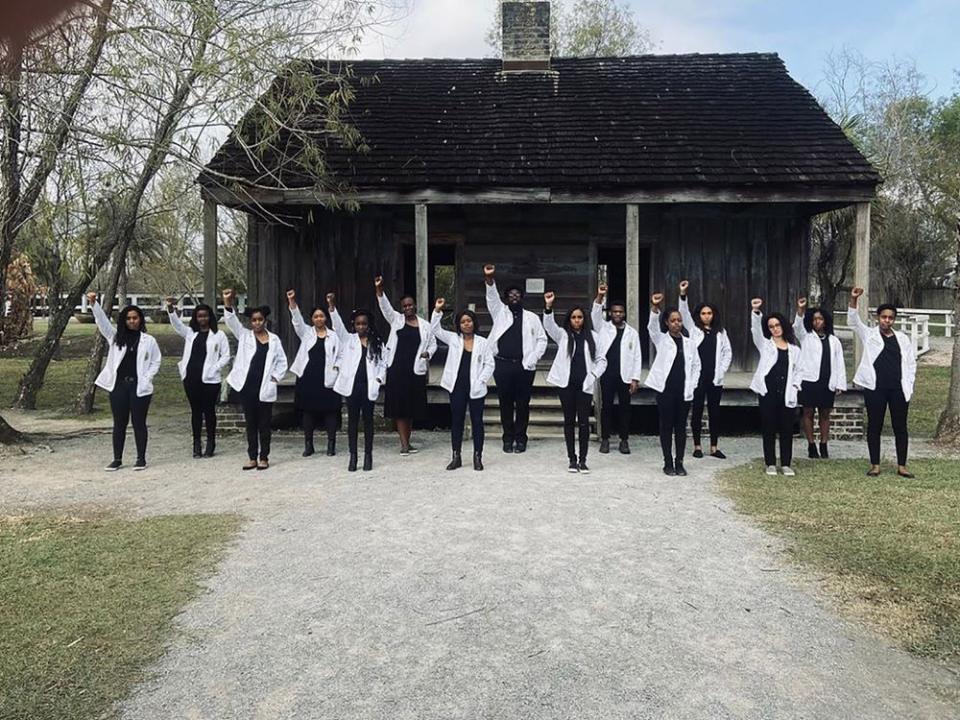Powerful Photo Shows Black Medical Students Standing on Former Slave Plantation in White Coats

A group of students from Tulane University’s School of Medicine is gaining attention after they gathered together at a former slave plantation in Louisiana to pose for a photo they say powerfully illustrates their “ancestral resiliency.”
The emotional impact of the photo is undeniable as the students, who are all part of the Student National Medical Association (SNMA) at Tulane, stand stoically in front of the former slave quarters at Whitney Plantation in Edgard while wearing their white coats — an idea that came to fruition thanks to the suggestion of Dr. Russell Ledet.
Ledet — who recently completed his Ph.D. and MBA, and is now working towards his MD — tells PEOPLE he was inspired to bring his classmates to the plantation in Edgard, which now operates as a slavery museum, after going with his friend and eldest daughter.
“My 8-year-old daughter was like, ‘Dad, it means a lot to be a black doctor in America. If you think about where we started… we made it pretty far,'” he explains. “I was like ‘You’re right, I think more of us should see this.'”
So Ledet proposed the idea to his Tulane classmates, emphasizing how the powerful image would illustrate “this connection between America’s past and America’s present,” as well as promote unity between the students as they pursue a career path that he says lacks diversity.

“[I said,] ‘I think this will be iconic and a lot of people will relate to it — this idea of how far we’ve come and how far we’ve gotta go,” he says. “For us, the struggle in medical school is real.”
Once they arrived at Whitney Plantation on Saturday, Ledet and his classmate Sydney Labat tell PEOPLE that each person had a different experience taking it all in.
“Initially, I didn’t understand what was going on because the emotions rushed through me,” Labat admits. “I started to cry thinking about [how] these people who we’re descendants of had the harshest life and the harshest conditions and wanted nothing but better for themselves and better for their children.”
“I am grateful that they were resilient because that allows me to be resilient and that allows me to be in this position that I am today,” Labat continues. “It was really overwhelming. I hope that I make them proud even in the smallest ways by living out my dream and being able to exercise my freedoms. A lot of us felt that way.”
Adds Ledet: “I kinda imagined this ancestral conversation where our ancestors looked down on us from heaven and said, ‘Look at our babies, they doing so well. I hope they’re happy, I’m so glad they came to see us.’ That kinda stuck with me… We literally are what no one thought we could ever be.”

Then, it was time for the three photos. In the first, the students stood staggered in front of the former slave quarters, proudly donning their white coats. The second showed them standing in the same position, but this time with their fists held high, while the last featured them gathered on the porch.
Though not every student who is involved with SNMA at Tulane University could attend — Labat says only 15 out of 65 people were there — the impact of the photos was no less powerful.
Since posting the images on Sunday on their respective social media accounts, the photos have gone viral with people of all races commenting on how the moving shots evoke emotions and self-reflection.
RELATED: Pinterest, the Knot to Stop Glamorizing the Use of Former Slave Plantations as Wedding Venues
“I’ve told a number of my classmates that I think we did something right and 50 years from now, people will still talk about this image,” Ledet says. “No matter how you feel about it, it’s a visceral reaction to ‘Here is what our country essentially started with and here’s how far we come.'”
“There’s a time gap in between where we’re standing and the house behind us that’s undeniable, that you have to recognize,” he continues. “There is a time gap that is literally filled by [the] landscape.”
For Labat, she says, “It is very much a symbol of education and striving for academic excellence and really shows how far we’ve come, and remind ourselves what we’re striving to achieve.”
RELATED VIDEO: Connecticut Bill Seeks to Bring African American and Latino Studies to High School Classrooms
And while there have been some who have responded negatively to the photos, both students confidently say on behalf of their group that they don’t let it get them down — because resilience is within them.
“We want people to see our hearts and to see that resilience is possible, to see that success is possible, whatever that may look like,” Labat explains. “Obstacles are there, but obstacles will be overcome.”
“The hope of the image is that people understand we’re trying. No matter what the system was initially set up for, we’re trying to go against that grain,” Ledet says. “There are still systemic issues that prevent [the] full flourishing of all people in America.”
“There’s definitely things in place that make sure that my process through medical school was a tad bit more challenging and I’m okay with that because I think the resiliency from our ancestral DNA is enough to get us past the challenges we face,” continues Ledet, who was formerly in the military and even once believed he couldn’t go to college, as he’d never known anyone who’d attended.
“It’s an illustration of our ancestral resiliency,” he proudly adds. “We could’ve just failed and said, ‘We don’t have it in us,’ but we’re here. We’re gonna all be MDs and we gonna all be MDs in our brown skin.”
